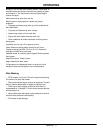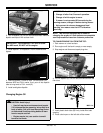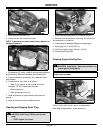
Operating - 10
OPERATING
When you mow an area for the first time, travel SLOW and
cut HIGH so you can:
• Learn the terrain.
• Learn the best mowing pattern.
• Help prevent hitting objects hidden in the grass.
Try to mow grass only when it is dry: Wet grass may plug
mower and leave a trail of grass clumps.
Use a travel speed that fits the conditions:
• Travel SLOW when you mow thick, tall grass.
• FAST travel or sharp turns may produce stripes or
uneven cut. Slow down. Short, fast turns may scuff ground
and pull grass out by the roots.
• Travel at MODERATE speed when you mow a thin stand
of grass.
Mow often enough so you cut only 1/3 of grass blade in one
mowing. Cutting grass too short may kill grass and let
weeds grow easily.
Aerate lawn to help stimulate soil organisms and root
growth.
To Avoid Scalping
• Pay attention to the way you mow: scalping can be
eliminated.
• If mower scalps easily, cutting height may be too low for
ground conditions–especially on lawns with many small
mounds and ridges.
• Mow over ridges and through shallow ditches straight-
on, not at an angle.
Keep blade sharp: A dull blade will tear grass; tips of grass
will then turn brown.
Check lawn regularly for uneven cut. If cut is uneven:
• Mower may not be level. Adjust cutting height levers.
Bagging Tips
For best performance, bagger needs good airflow. To help
increase airflow:
• Keep underside of deck and chute clean.
• Cut grass high.
• Clean bag often with water from garden hose, from
outsidetoinsideofbag.Letbagdrybeforeuse.
When bag is full:
• Mower may leave a trail of clippings.
• Clippings may blow out from under deck.
• Top of bag will deflate.
Bagging and Composting
Many communities will no longer haul lawn clippings and
leaves to landfills. Bagging and composting clippings and
leaves is one way to solve this problem.
Clippings from grass bag may also be used as mulch, or
sheet compost, between garden rows and around trees
and shrubs. This mulch will:
• Keep weeds from growing.
• Help soil keep moisture.
• Add nutrients to soil as it decays.
• Help keep soil temperature down during hot weather.
You may compost clippings and leaves in various ways.
See garden magazines or clubs for information, or go to
your local library for help.
Finished compost is crumbly. It is rich in soil nutrients, and
can be spread on your lawn. Compost may also be worked
into soil. It adds humus to soil and improves soil texture,
making soil looser and easier to work.
Mulching Tips
Advantages:
• You do not have to rake or bag grass or leaves.
• Lawn holds moisture better during dry weather.
• Soil temperatures stay down during hot weather.
• Mulch adds nutrients to soil, and reduces need for
fertilizer.
Mulching does not make thatch. Frequent shallow watering
and fertilizer application produce thatch from roots that
grow close to surface.
Be careful when you mulch leaves in Fall. Grass needs
IMPORTANT: Avoid damage! DO NOT leave
clippings in bag:
• Moisture may damage bag.
• Damp clippings are a fire hazard.


















